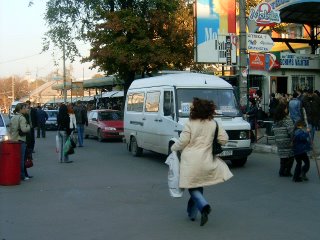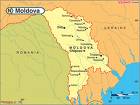
What a ride I had tonight!! Whoa! At one point I felt like I was standing on the back of a horse – bareback – holding the reigns and riding standing up trying to keep my balance for all I was worth. I am finally starting to learn my lesson about routieres (no, I don't know the proper spelling), I think. Did I tell you, by the way, that I call them ‘miracle boxes’? That’s because miracles do happen every day in Moldova when 2 or 3 times as many people squeeze onto these mini-buses intended to seat 14-16 people. When they were built, nobody indicated to any Moldovans that there might be a limit on how many could stand in one. So, for example, the other day when I was hoping to get on one and the person before me was not moving any farther into the bus allowing space for me, the woman behind me actually started pushing me onto the bus so that there could be room for her too. I wasn’t in a big hurry, so I stepped back and let her perform the Moldovan miracle as the bus drove off with her safely(or not) squished against the door(see rules 7 & 8).
So - here are the rules for riding on these miracle boxes:
1. If you want to catch the much more convenient (large) bus from Chisinau centre to Ialoveni, find out BEFOREHAND what time the last bus leaves from the station. It will save you from waiting in the cold for an hour, hoping a bus might come, meanwhile missing two routieres that would take you where you want to go eventually.
2. Find out where some of the other routieres go so that you will know alternate routes on such an occasion.
3. If you have to get off before the final stop (once you actually get on a minibus), don’t move, or allow yourself to be moved to the back of the bus. Otherwise, even if you do know where you want to get off and try to call out and are not heard-or understood – you will miss the ideal place to get off. Also, if you’re still stuck at the back when the minibus stops, you may not manage to get off before more people are squeezing into the front door against impossible odds. (Tonight the door closed before I got to it and I had to cry out in my impeccable Romanian – “No, no, no. I’m going. Stop! Wait! and in English – please let me off!!)
4. It is actually preferable to ride the routieres only during daylight hours so you can, in fact, determine where it is you want to get off. One of the interesting things about these buses is that the driver keeps the inside lights all on at night so you really can’t see out the windows – and don’t forget there are very few streetlights in Moldova.
5. Have your money ready to pay the driver, and pass it to him straightened out, not crumpled up. He likes that better. And if you didn’t pay him when you got on the bus, remember to pay him before you get off. (Some routes you pay on entry, others on exit.)
6. If you need change, sometimes it helps him if you tell him what you have passed to him. You may think that keeping a foothold as the minibus swerves around a corner, narrowly missing the trolley on its right and the car trying to pass in the non-lane on the left, is a challenge, but think of the driver. He has to maneuver on Chisinau streets and make change at the same time. And sometimes he has to do that while arguing or having a conversation with a passenger. (I can’t tell the difference yet.). Don’t expect him to double-check the bill you just gave him.
7. If you are able to stay near the front – actually, if you are unable to move anywhere beyond the immediate right of the driver, squished with 3 other people between the driver and the door, it is in your best interest not to block the driver’s view of the rear-view mirror on the right, especially if it is time for the customary race on the highway with the closest routiere going in the same direction. Also, figure out a way to stabilize yourself, firmly planting your feet on the floor, bracing yourself, holding a bar if possible but otherwise bracing your hand or your elbow or even your head against the ceiling. It is probably not a good idea to lean against the door and it is in your best interest, no matter which way the van lurches, not to push your knee against the gear shift nor to land in the driver’s lap. Fall towards the back of the bus – it may actually help people to move back more effectively anyway.
8. Again, with a preference for driving in daylight hours, if you do not urgently need to get on a crowded bus to get somewhere fast, why bother? It’s much easier to wait for the next bus and maybe get a seat on it.
9. If you can actually get a seat and you will be getting off at the last stop, or the most popular stop, feel free to sit in a window seat halfway back. There are three advantages to this:
a. you aren’t above the wheel going over the bumpy roads.
b. All of you is on the seat. When you’re on the aisle seat, sometimes you can only get one half of your backside on the seat, especially if you are a generously built person, sitting next to another generously built person. And with only one half of your bottom on the seat you still have to brace your legs almost as much as if you were standing - to ensure you don’t fall off the seat going around those corners.
c. Halfway back is better than near the front where you have to be passing people’s money back and forth to the driver. (Another interesting thing about these buses. People pay once they get safely seated. I.e. if you sit in the back seat, once safe and sound you can pull out your money and pass it to the person in front of you, who in turn passes it along till it gets to the driver. If you need change, it is passed back from the driver through all the intermediary people, just the way it came.
10. Find out what you need to say and exactly where you need to say it, so that the driver can drop you safely right at your front door, without slamming on the brakes and causing you to go flying out the front door.
11. “Mergi cu Domnului.” (Go with God.)







No comments:
Post a Comment